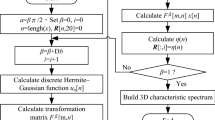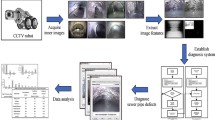Abstract
Partial discharge (PD) measurement is used for a diagnosis and performance assessment of the solid insulation material inside the high-voltage (HV) equipment. PD measurement indicates the presence of voids, cracks and imperfection present in solid insulation material. The major problem associated with this measured PD signal is heavily contaminated by noise which results in reduction in PD pattern recognition. The objective of this work is to measure and de-noise the PD signal due to cavity and recognize two different size of cavities present in three different locations, namely near HV electrode, center and lower electrode. In first part, the measured PD signal is de-noised using translation invariant wavelet transform. In second part, the three-dimensional (φ–q–n) PD patterns are extracted from the de-noised PD data. Then, it is subjected to canny edge detection technique, and the features like horizontal and vertical fractal dimension averages are evaluated using fractal image compression-based semi-variance technique. For classification, multi-class nonlinear support vector machine has been proposed to classify position and size of the cavity based on the PD fingerprints. The findings of this proposed work can be used to design a solid basis for an recognition of cavity size and position in an electrical apparatus.









Similar content being viewed by others
Explore related subjects
Discover the latest articles, news and stories from top researchers in related subjects.References
Abdel-Galil TK, Sharkawy RM, Salama MM, Bartnikas R (2005) Partial discharge pattern classification using the fuzzy decision tree approach. IEEE Trans Instrum Meas 54(6):2258–2263
Abe S (2010) Support vector machines for pattern recognition. Adv Pattern Recognit. https://doi.org/10.1007/978-1-84996-098-4
AkramBajwa A, Habib S, Kamran M (2015) An investigation into partial discharge pulse extraction methods. Electr Power Energy Syst 73:964–982
Al-Smadi M, Qawasmeh O, Al-Ayyoub M, Jararweh Y, Gupta B (2018) Deep Recurrent neural network vs. support vector machine for aspect-based sentiment analysis of Arabic hotels’ reviews. J Comput Sci 27:386–393
Ashtiani MB, Shahrtash SM (2012) Feature-oriented de-noising of partial discharge signals employing mathematical morphology filters. IEEE Trans Dielectr Electr Insul 19(6):2128–2136
Babnik T, Aggarwal R, Moore P (2007) Data mining on a transformer partial discharge data using the self-organizing map. IEEE Trans Dielectr Electr Insul 14(2):444–452
Basharan V, Siluviraj WIM, Velayutham MR (2018) Recognition of multiple partial discharge patterns by multi-class support vector machine using fractal image processing technique. IET Sci Meas Technol 12(8):1031–1038
Chen HC (2012) Fractal features-based pattern recognition of partial discharge in XLPE power cables using extension method. IET Gener Transm Distrib 6(11):1096–1103
Christmann A, Steinwart I (2010) Support vector machines. Comput Sci. https://doi.org/10.1007/978-0-387-77242-4
Cunha CF, Carvalho AT, Petraglia MR, Lima AC (2015) A new wavelet selection method for partial discharge de-noising. Electr Power Syst Res 125:184–195
de Oliveira Mota H, da Rocha LCD, de Moura Salles TC, Vasconcelos FH (2011) Partial discharge signal de-noising with spatially adaptive wavelet thresholding and support vector machines. Electric Power Syst Res 81:644–659
Greatwood C, Richards AG (2019) Reinforcement learning and model predictive control for robust embedded quadrotor guidance and control. Auton Robots 43(7):1681–1693
Gulski E (1993) Computer-aided measurement of partial discharges in HV equipment. IEEE Trans Electr Insul 28:969–983
Gupta S, Gupta BB (2017) Detection, avoidance, and attack pattern mechanisms in modern web application vulnerabilities: present and future challenges. Int J Cloud Appl Comput 7(3):1–43
Gutfleisch F, Niemeyer L (1995) Measurement and simulation of PD in epoxy voids. IEEE Trans Dielectr Electr Insul 2(5):729–743
Illias H, Chen G, Lewin PL (2011a) Partial discharge behavior within a spherical cavity in a solid dielectric material as a function of frequency and amplitude of the applied voltage. IEEE Trans Dielectr Electr Insul 18(2):432–443
Illias H, Chen G, Lewin PL (2011b) Modeling of partial discharge activityin spherical cavities within a dielectric material. IEEE Electr Insul Mag 27(1):38–45
Illias HA, Chen G, Lewin PL (2012) Partial discharge within a spherical cavity in a dielectric material as a function of cavity size and material temperature. IET Sci Measur Technol 6(2):52–62
Jararweh Y, Al-Ayyoub M, Fakirah M, Alawneh L, Gupta BB (2019) Improving the performance of the needleman-wunsch algorithm using parallelization and vectorization techniques. Multimed Tools Appl 78(4):3961–3977
Khan Y, Khan A, Budimana FN, Beroual A, Malika NH, Al-Arainya AA (2014) Partial discharge pattern analysis using support vector machine to estimate size and position of metallic particle adhering to spacer in GIS. Electr PowerSyst Res 116:391–398
Ma Z, Yang Y, Kearns M, Cowan K, Yi H, Hepburn DM, Zhou C (2018) Fractal-based autonomous partial discharge pattern recognition method for MV motors. IET High Volt. https://doi.org/10.1049/hve.2017.0109
Maheswari RV, Subburaj P, Vigneshwaran B, Willjuice Iruthayarajan M (2014a) Partial discharge signal denoising using adaptive translation invariant wavelet transform—online measurement. J Electr Eng Technol 9(2):695–706
Maheswari RV, Subburaj P, Vigneshwaran B, Kalaivani L (2014b) Non linear support vector machine based partial discharge patterns recognition using fractal features. J Intell Fuzzy Syst 27(5):2649–2664
Majidi M, Fadali MS, Etezadi-Amoli M, Oskuoee M (2015) Partial discharge pattern recognition via sparse representation and artificial neural network. IEEE Trans Dielectr Electr Insul 22(2):1061–1070
Majidia M, Oskuoeeb M (2015) Improving pattern recognition accuracy of partial discharges by new data preprocessing methods. Electr Power Syst Res 119:100–110
Núñez H, Angulo C, Català A (2006) Rule-based learning systems for support vector machines. Neural Process Lett 24(1):1–18
Raymond WJK, Illias HA (2017) Classification of partial discharge measured under different levels of noise contamination. PLoS ONE 12:1–20
Raymond WJK, Illias HA, Mokhlis H (2015) Partial discharge classifications: review of recent progress. Measurement 68:164–181
Satish L, Zaengl WS (1994) Artificial neural networks for recognition of 3-D partial discharge patterns. IEEE Trans Dielectr Electr Insul 1(2):265–275
Subasi A (2015) A decision support system for diagnosis of neuromuscular disorders using DWT and evolutionary support vector machines. SIViP 9(2):399–408
Tyagi B, Vidya HA (2013) Application of wavelet shrinkage de-noising method based on genetic algorithm to partial discharge signals. In: Proceedings of international conference on VLSI, communication, advanced devices, signals and systems and networking (VCASAN-2013), pp 228–273
Van M, Kang H, Shin K (2014) Rolling element bearing fault diagnosis based on non-local means de-noising and empirical mode decomposition. IET Sci Meas Technol 8(6):571–578
Xiao DS, Cheng KZ, Donald MH (2007) Second generation wavelet transform for data de-noising in PD measurement. IEEE Trans Dielectr Electr Insul 14(6):1531–1537
Zhang Y, He L, Zhu H (2019) Influencing factors of partial discharge of needle-plate based on acoustic emission detection. In: World conference on acoustic emission WCAE 2017: advances in acoustic emission technology, pp 389–397
Zhu Y, Jia Y, Wang L (2016) Partial discharge pattern recognition method based on variable predictive model-based class discriminate and partial least squares regression. IET Sci Meas Technol 10(7):737–744
Acknowledgements
This work is financially supported by the Department of Science and Technology—fund for improvement of S&T infrastructure in universities and higher educational institutions (DST-FIST) Grant ID (SR/FST/College-061/2017) and also the authors are grateful to the management of the National Engineering College, Kovilpatti, Tamilnadu, India.
Author information
Authors and Affiliations
Corresponding author
Ethics declarations
Conflict of interest
The authors declare that they have no conflict of interest.
Ethical approval
This article does not contain any studies with human participants or animals performed by any of the authors.
Informed consent
Informed consent was obtained from all individual participants included in the study.
Additional information
Communicated by V. Loia.
Publisher's Note
Springer Nature remains neutral with regard to jurisdictional claims in published maps and institutional affiliations.
Rights and permissions
About this article
Cite this article
Vigneshwaran, B., Willjuice Iruthayarajan, M. & Maheswari, R.V. Partial discharge pattern analysis using multi-class support vector machine to estimate cavity size and position in solid insulation. Soft Comput 24, 10645–10656 (2020). https://doi.org/10.1007/s00500-019-04570-7
Published:
Issue Date:
DOI: https://doi.org/10.1007/s00500-019-04570-7




